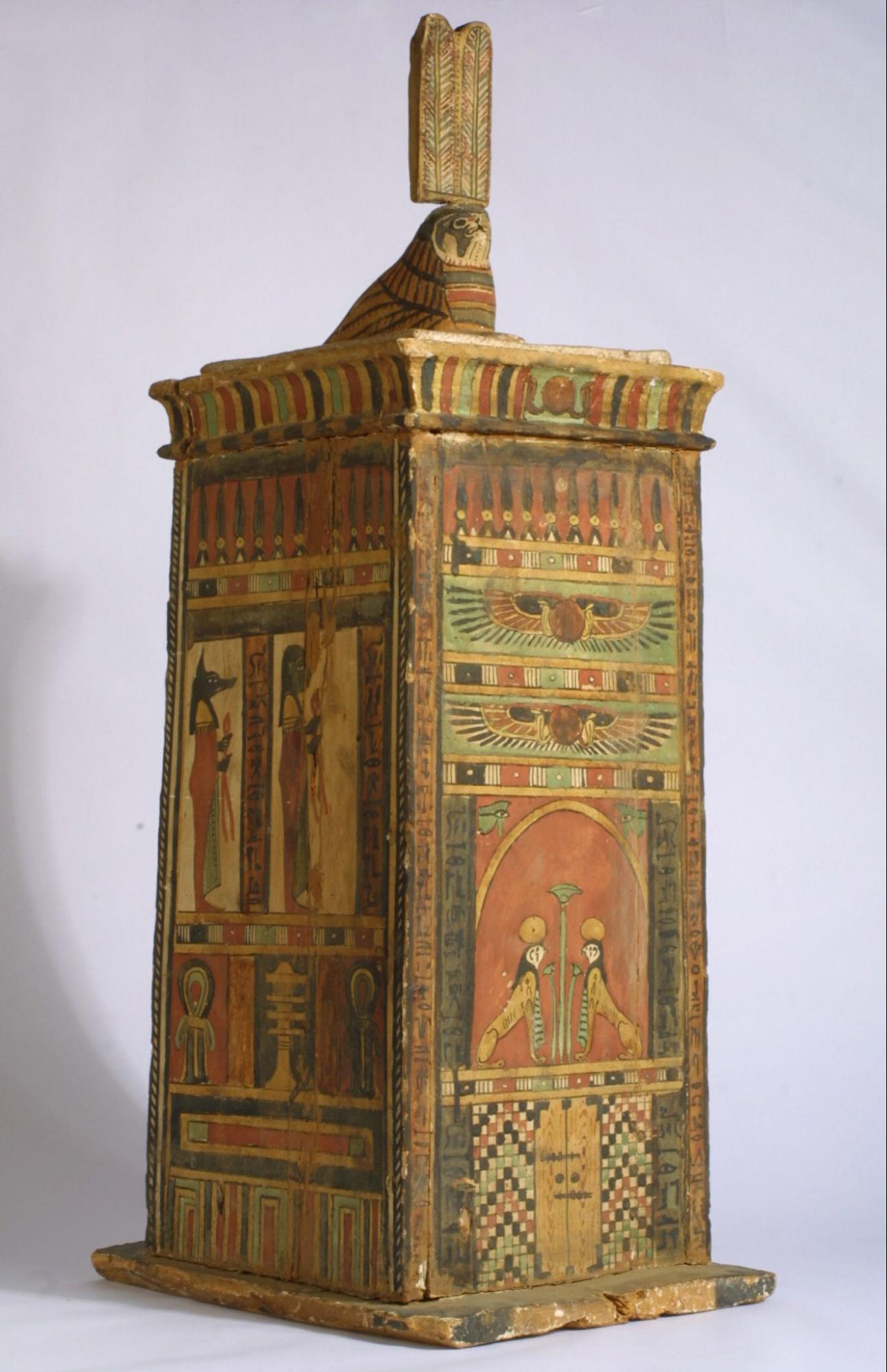Representing a divine shrine, this canopic chest was designed to offer physical and spiritual protection to the deceased’s mummified internal organs. The four tapered sides narrow at the top and are crowned by a cavetto cornice, which mimics the architectural details found above temple doors and shrines. The front of the richly decorated chest is carefully painted with a single pair of bolted doors, while on the sides, the niche façades symbolize the walls of temples and funerary enclosures. Like the orientation of full-sized architecture on which this chest is based, the front entrance is associated with the south.
The owner of the chest is identified as Dibastet. The clearest representations of Dibastet’s name are on the sides showing the d-hand, the b-foot, and the sealed oil jar. The theophoric name honoring the cat goddess Bastet is attested in the Ptolemaic period for both males and females. On the columns framing either side of the front panel, the expression of filiation is rendered differently: in the left column, the egg is followed by a stroke indicating he may be a son, while on the right the egg-hieroglyph is followed by a t-loaf indicating that Dibastet may be female and a daughter.
In addition to the architectural form, the chest displays deities who will offer spiritual protection to the owner in the afterlife. On the front and back of the chest are different representations of the solar falcon god Horus the Behdetite, who represented rebirth in the afterlife for nonroyal elite in the Late and Ptolemaic periods.1 Protection is mirrored through image and text by the four sons of Horus depicted on the left and right sides, representing the western and eastern cardinal directions.2 As with earlier periods, these four gods—often depicted on canopic jar lids that held the four mummified internal organs—are the baboon-headed Hapy, the falcon-headed Qebensenuef, the jackal-headed Duamutef, and the human-headed Imseti. Each of the four gods holds the symbol for protection in their hands reflecting their accompanying text. Beneath each pair of gods are amuletic symbols: the Djed-pillar symbolizing the backbone of Osiris, flanked by the Isis-knot (tyet). Surmounting the chest is the mummified falcon god, Sokar, who assisted and protected the deceased’s spiritual transfiguration during the journey through the underworld. Protective recitation texts on the front left, and right sides of the chest confirm that Dibastet has transformed into a divine being. In these texts, she is called Osiris-Dibastet, a transformation name that reflects that she has transfiguration into an Osirian being.3
-
Shonkwiler, Randy L. 2014. “The Behdetite: A Study of Horus the Behdetite from the Old Kingdom to the Conquest of Alexander.” Ph.D. diss., The University of Chicago.. ↩︎
-
Wilkinson, Richard H. 1994. Symbol & Magic in Egyptian Art. London: Thames and Hudson.. ↩︎
-
Hornung, Eric. 1996. Conceptions of God in Ancient Egypt: The One and the Many. Ithaka, NY: Cornell University Press.. ↩︎
Bibliography
- Hornung 1996
- Hornung, Eric. 1996. Conceptions of God in Ancient Egypt: The One and the Many. Ithaka, NY: Cornell University Press.
- Shonkwiler 2014
- Shonkwiler, Randy L. 2014. “The Behdetite: A Study of Horus the Behdetite from the Old Kingdom to the Conquest of Alexander.” Ph.D. diss., The University of Chicago.
- Wilkinson 1994
- Wilkinson, Richard H. 1994. Symbol & Magic in Egyptian Art. London: Thames and Hudson.
